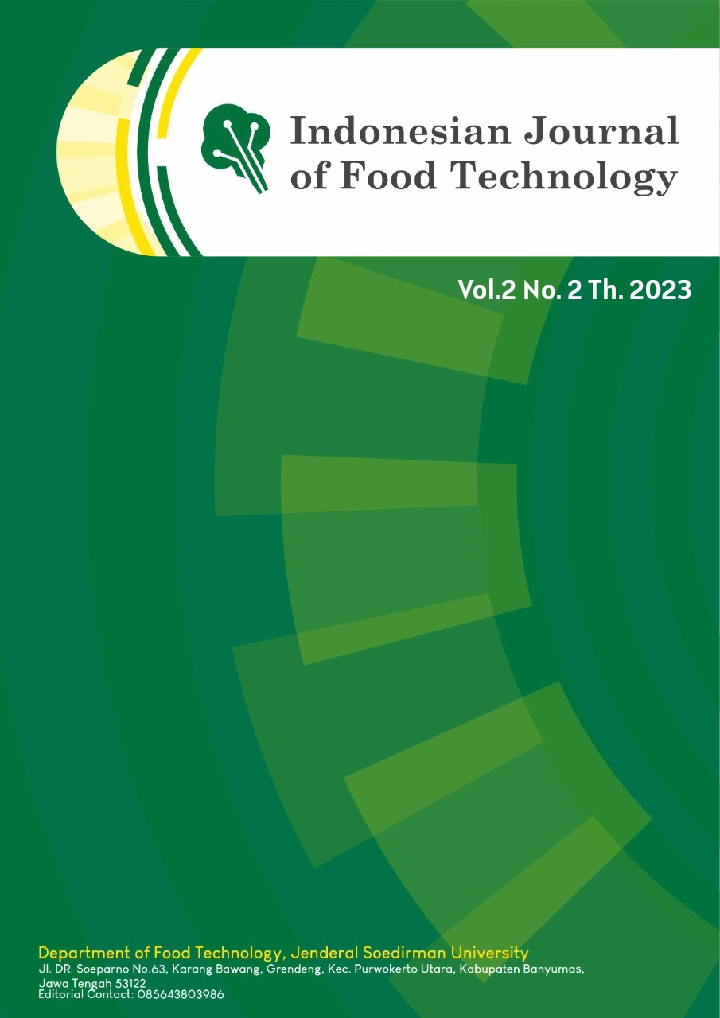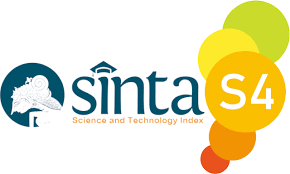Potential Utilization of Sesame Seed Coat as Raw Material for Flour Production
Abstract
Sesame seed coat is a by-product from hulled sesame seed industry which has high nutritional content but still has low economic value because it is only used in animal feeding. The purpose of this study is to explore the potential of sesame seed coat as a raw material for making flour by looking at the protein content, dietary fiber, food safety, and antioxidant potential so it can be recovered and used as a value added product. Temperature and time in drying can be the factor that determines the final quality. This study was conducted to investigate the best experimental design in combination of drying temperature and time to acquire the best water content, protein content and fiber content on flour. Testing for microbial contamination with total yeast and mold count and testing for chemical contamination of heavy metals such as mercury (Hg), cadmium (Cd), and lead (Pb) were also carried out to ensure food safety. Testing for antioxidant activity and ferulic acid content were also carried out to determine the potential of sesame seed coat flour as an antioxidant-rich food. The results of this study showed that the best temperature and drying time for making sesame seed coat flour was 60oC and 6 hours. In that conditions, the water content, protein content, total dietary fiber content, antioxidant activity, and ferulic acid content were 13,3333%, 7,3537%, 21,6947, 5.871,2381 ppm, and 8,749 mg/kg respectfully for each category. In the microbial test, the results showed that the number of molds and yeast was 8 x 103 colonies/g, while for the chemical contamination test, it was 0.04 mg/kg for mercury, 0.67 mg/kg for cadmium, and undetectable amount for lead.
References
Agustina, T. (2014). Kontaminasi Logam Berat pada Makanan dan Dampaknya pada Kesehatan. Jurnal TEKNOBUGA, 1,53-65.
Anthony, M.H., Ojochenemi, A.D., Yemi, A.H.R.Y., Tahir, N., Okechukwu, O.J., Saidu, M.A. & Ayobami, O.B. (2014.) Determination of Aflatoxins in Sesame, Rice, Millet and Acha from Nigeria using HPLC. Journal Chemical Science Transactions, 3,1516-1524.
Basu, A., Alman, A.C., & Snell-Bergeon, J.K. (2019). Dietary fiber intake and glycemic control: coronary artery calcification in type 1 diabetes (CACTI) study. Nutrition Journal, 18,1-8.
Chen, X., Lu, J., Li, X., Wang, Y., Miao, J., Mao, X., Zhao, C., & Gao, W. (2017). Effect of blanching and drying temperatures on starch-related physicochemical properties, bioactive components and antioxidant activities of yam flours. Journal LWT Food Science and Technology, 82,303-310.
Diza, Y.H., Wahyuningsih, T., & Silfia. (2014). Penentuan Waktu dan Suhu Pengeringan Optimal terhadap Sifat Fisik Bahan Pengisi Bubur Kampiun Instan Menggunakan Pengering Vakum. Jurnal Litbang Industri, 4:105-114.
Elleuch, M. (2007). Quality Characteristics of Sesame Seeds and By-products. Food Chemistry, 103,641-650.
Faustino, M., Veiga, M., Sousa, P., Costa, E.M., Silva, S., & Pintado, M. (2019) .Agro-Food Byproducts as a New Source of Natural Food Additives. Molecules, 24,1-23.
Finocchiaro, F., Ferrari, B., Gianinetti, A., Dall'asta, C., Galaverna, G., Scazzina, F. & Pellegrini, N. (2007). Characterization of antioxidant compounds of red and white rice and changes in total antioxidant capacity during processing. Journal of Molecular Nutrition and Food Research, 51,006-1019.
Görgüç, A., Bircan, C. & Yılmaz, F. M. (2019). Sesame Bran as an Unexploited By-product: Effect of Enzyme and Ultrasound-assisted Extraction on the Recovery of Protein and Antioxidant Compounds. Food Chemistry, 283,637-645.
Hasnani, S. Jamaludin, P., & Fadilah, R. (2019). Pengaruh Teknik Penyimpanan terhadap Pengendalian Aflatoksin Jagung (Zea mays L) selama Penyimpanan. Jurnal Pendidikan Teknologi Pertanian, 5,S37-S47.
Isıklı, B., Demir, T.A., Akar, T., Berber, A., Urer, S.M., Kalyoncu, C., & Canbek, M. (2006). Cadmium exposure from the cement dust emissions: A field study in a rural residence. Chemosphere, 63,1546-1552
Johansson, M. (2012). Dietary fibre composition and sensory analysis of heat treated wheat and rye bran. Tugas Akhir. Department of Food Science Swedish University of Agricultural Sciences.
Kementerian Kesehatan Republik Indonesia. (2018). Riset Kesehatan Dasar 2018, Jakarta: Kementerian Kesehatan.
Kenang, V., Koapaha, T., & Langi, Tineke, M. (2022). Substitusi Tepung Kulit Ari Kedelai (Glycine Max) dalam Pembuatan Cookies Kaya Serat dan Protein dengan Flavor Kulit Jeruk Manis (Citrus sinensis L.). Jurnal Teknologi Pertanian, 13,16-25.
Kusnandar, F. (2019). Kimia Pangan Komponen Makro. Jakarta: Bumi Aksara.
Lai, W.T., Khong, N.M.H., Lim, S.S., Hee, Y.Y., Sim, B.I., Lau, K.Y., dan Lai, O.M. (2016). A review: Modified Agricultural By-products for the Development and Fortification of Food Products and Nutraceuticals. Trends in Food Science & Technology, 59,148-1600.
Leksono, W.B., Pramesti, R., Santosa, G.W., & Setyati, W.A. (2018). Jenis Pelarut Metanol Dan N-Heksana Terhadap Aktivitas Antioksidan Ekstrak Rumput Laut Gelidium sp. Dari Pantai Drini Gunungkidul – Yogyakarta. Jurnal Kelautan Tropis, 21,9-16.
Molyneux, P. (2004). The use of the Stable Free Radical 2-2-diphenil-2-pikrilhidrazin (DPPH) for Estimating Antioxidant Activity. Songklanarin J. Sci. Technology, 26,211-219.
Nakai, V.K., Rocha, L.O., Goncalez, E., Fonsesca, H., Ortega, E.M.M., & Correa, B. (2007). Distribution of fungi and aflatoxins in a stored peanut variety. Journal of Food Chemistry, 106,285-290.
Ortega-Hernández, E., Coello-Oliemans, C., Ornelas-Cravioto, A., Santacruz, A., Becerra-Moreno, A., & Jacobo-Velazquez, D.A. (2018). Phytochemical Characterization of Sesame Bran: An Unexploited By-product Rich in Bioactive Compounds. CyTA - Journal of Food, 16,814-821.
Pan, J., Plant, J.A., Voulvoulis, N., Oates, C.J., & Ihlenfeld, C. (2010). Cadmium levels in Europe: implications for human health. Environmental Geochemistry and Health, 32,1-12.
Puslitbang Departemen Kesehatan (Depkes) RI. (2013). Konsumsi Serat Masyarakat Indonesia. Departemen Kesehatan Jakarta.
Puspitasari, R.F., Prasetya, A., & Rahayuningsih. (2019). Penurunan Logam Hg dalam Air Menggunakan Sistem Sub-Surface Flow Constructed Wetland: Studi Efektivitas. Jurnal Rekayasa Proses, 13,41-46.
Ravindran, R. & Jaiswal, A. K. (2016). Exploitation of Food Industry Waste for High-Value Products. Trends in Biotechnology, 34,58-69.
Sapna, I., Kamaljit, M., Priya, R., & Jayadeep, P.A. (2019). Milling and thermal treatment induced changes on phenolic components and antioxidant activities of pigmented rice flours. Journal of Food Science Technology, 51,273-280.
Shaikh, H.A.R. dan Jain, V. (2018). A Novel, Simple, Rapid RP-HPLC Method for Simultaneous Estimation of Ferulic Acid, Quercetin, Piperine, and Thymol in Ayurverdic Formulation. International Journal of Applied Pharmaceutics, 10,303-308
Sunarti. (2017). Serat Pangan dalam Penanganan Sindrom Metabolik. Yogyakarta: UGM Press.
United State Departement of Agriculture. 2019. Wheat flour, white, all-purpose, unenruched. https://fdc.nal.usda.gov/fdc-app.html#/food-details/169761/nutrients.











